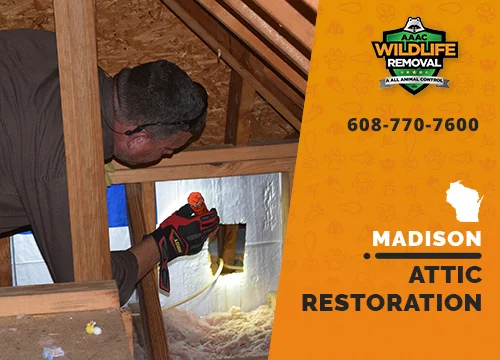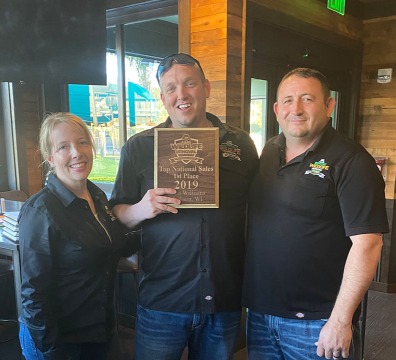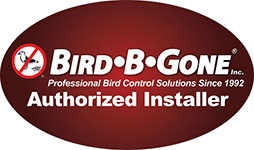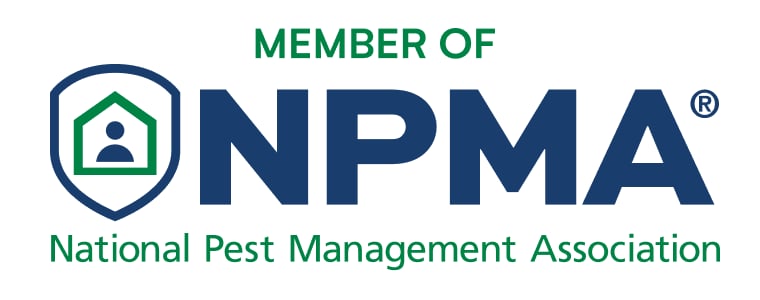How we restore your attic
Pests may not be able to chew through insulation, but they can certainly tear it up. The insulation material can be used as more than bedding. After all, the animals who are chewing at your attic’s ceilings will find a place for themselves in those holes, and then leave behind their own contaminants, such as urine and stool. These areas are also less efficient at insulating air, allowing for air to escape or enter. This can lead to costly repairs. Here are some steps to follow when attic restoration is completed.

Scoop out Larger Feces Clumps
The first step of an attic restoration is to remove large amounts of feces left behind by insects. To get rid of the droppings from walls and ceilings, we use a long-handled device. If the droppings are dry or stuck on hard surfaces we will soak them in water, and then use a wire brush for scraping them off.
AAAC technicians use an extended handle tool to climb onto the roof of your home to find high-risk areas where squirrels and rats often leave feces. It is possible that large quantities of droppings are needed to be removed from rafters and the eaves by the technicians.

Vacuum Small Feces
A thorough vacuuming of small rodent waste pellets from attics is the next step in any attic renovation project. Mice, rats, and other forms of rodent leave behind large amounts of tiny feces that can only be removed using this method. AAAC uses a specialized machine that has a long enough hose to reach all parts of your attic. The machine comes with an extra-long vacuum tube, high-velocity suction, and HEPA filter for removing animal hairs and droppings from insulation and other surfaces. AAAC has a special brush attachment to reach small droppings in tight corners and ceilings. This attachment is designed to reach tight areas, such as corners and areas near the roof.
AAAC uses UV light to locate small feces hidden in attics. UV light will produce black dots wherever feces are left behind by animals, including bats, rats, and raccoons.

Air Duct Cleaning & Repair
AAAC Wildlife Control offers duct repair and restoration services. This includes removing animal hair, droppings and urine from the ductwork. AAAC uses a specially designed tool to clean the inside of ducts and remove any debris. Once that is completed, we can spray a disinfectant over the ducts to kill any bacteria, viruses, or rodents that may have been left behind.

Decontaminate the Attic
The most important part of an attic restoration project after removing the critters is the decontamination of the attic of rodent feces and urine. This is an extremely important part of any attic restoration project. It’s done in order to protect your family against microbial pathogens which could be harmful if inhaled.
AAAC Wildlife Removal uses a UV light to identify areas that may have been infested with rodent droppings. After cleaning the affected areas and surfaces, technicians will use a disinfectant spray. This kills any microorganisms found in animal feces.
AAAC Wildlife Removal will spray a fine mist into the attic to kill microorganisms. The electric atomizer sprayer creates a cloud of microscopic droplets that cannot be seen by the human eye. As the droplets evaporate, they produce a chemical residue that’s toxic to microorganisms such as algae, molds, bacteria, and viruses.
Drying is crucial in attic restoration services because it eliminates moisture which can promote mold growth. AAAC may use a humidifier to remove moisture from insulation and attic wood. This helps to prevent mold growth in the attic space during re-insulation.

Full Attic Insulation Replacement
This part of the restoration work is completed by removing old insulation and then installing a brand new one. The old insulation must be removed carefully to prevent ruining adjacent areas or leaving a mess behind. Insulation is normally wrapped around rafters or joists, so be careful when pulling them, lest they cause damage to some of the wooden structures.
Mold spores and other potentially harmful materials are often found in the insulation and can be released into the air when it is removed. Our technicians are required to wear masks in order not to breathe in any dangerous particles or substances that could get into the ducts.
The technicians will remove the old insulation and install the new insulation. The insulation must fit snugly around rafters or joists. Although cutting things close can lead to some leftover insulation. Also, the technicians use masking tape to secure everything during installation.
What is full attic restoration?
Attic Restoration is a process that restores the function and appearance to an attic. Attic restoration can include insulation, cleaning up waste, and decontamination.
When attics get dirty and dusty due to animal droppings, accumulated dirt, or ice accumulation, their ability to insulate is often reduced. This is a way for more energy to escape your home than if you had insulation intact. The decontamination process starts with using fans in interior spaces where moisture has accumulated.
How do you disinfect an attic?
Remove old insulation. Use an ultraviolet sterilizer and disinfectant to decontaminate it. Finally, sanitize the area to kill bacteria. It is essential to clean all surfaces which have been exposed to contaminated material in order not to reinfect.
To ensure safe and efficient disinfection, the process starts with removing insulation. For attic restoration, you will need to use a powerful suction device to remove any harmful materials, such as mold and bacteria, from surfaces like wood beams or rafters. After the suction process is finished, a biocides washdown is used to kill any remaining mold. The antimicrobial compound also prevents mold and mildew from growing in the future. Finally, the area will be sterilized by light sterilization using UV lights similar to those used for hospitals.
Total attic restoration solutions
AAAC Wildlife Removal offers attic restoration services. We can clean out attics after wildlife removal. We clean animal feces, remove soiled insulation, and re-insulate the attic to bring it back to its original condition. AAAC Wildlife will soak any droppings that have dried on hard surfaces or gotten stuck, then use a wire brush to remove them. AAAC Pest Control employs a special tool with a long handle that can reach high places where squirrels, raccoons, and other animals often leave feces. If you need your air ducts completely decontaminated and cleaned of animal droppings and hair, we offer Air Duct Cleaning and Repair too. Get your attic back by calling us today!









